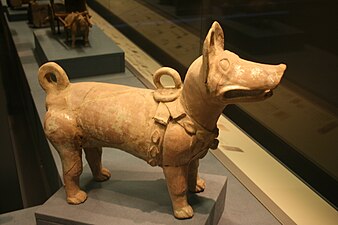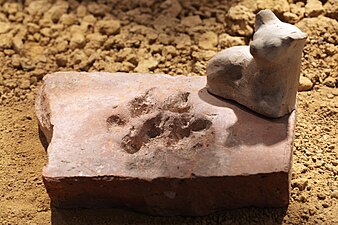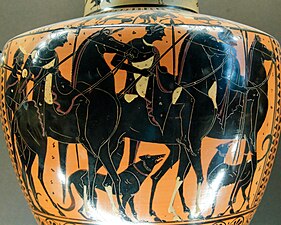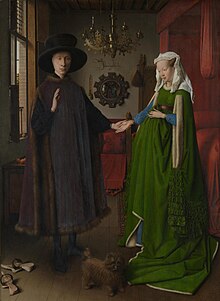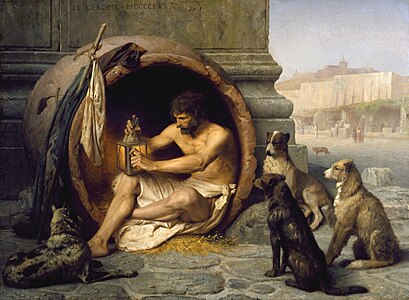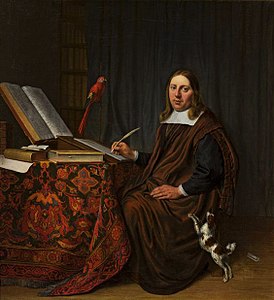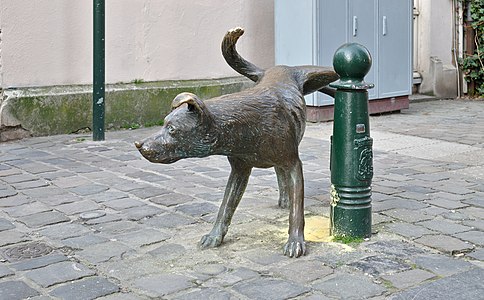
Anubis, also known as Inpu, Inpw, Jnpw, or Anpu in Ancient Egyptian, is the god of funerary rites, protector of graves, and guide to the underworld, in ancient Egyptian religion, usually depicted as a canine or a man with a canine head.

The beagle is a breed of small scent hound, similar in appearance to the much larger foxhound. The beagle was developed primarily for hunting hare, known as beagling. Possessing a great sense of smell and superior tracking instincts, the beagle is the primary breed used as a detection dog for prohibited agricultural imports and foodstuffs in quarantine around the world. The beagle is a popular pet due to its size, good temper, and a lack of inherited health problems.

The EnglishGreyhound, or simply the Greyhound, is a breed of dog, a sighthound which has been bred for coursing, greyhound racing and hunting. Since the rise in large-scale adoption of retired racing Greyhounds, the breed has seen a resurgence in popularity as a family pet.

The Siberian Husky is a medium-sized working sled dog breed. The breed belongs to the Spitz genetic family. It is recognizable by its thickly furred double coat, erect triangular ears, and distinctive markings, and is smaller than the similar-looking Alaskan Malamute.

A dog breed is a particular type of dog that was purposefully bred by humans to perform specific tasks, such as herding, hunting, and guarding. Dogs are the most variable mammal on Earth, with artificial selection producing upward of 360 globally recognized breeds. These breeds possess distinct traits related to morphology, which include body size, skull shape, tail phenotype, fur type, body shape, and coat colour. However, there is only one species of dog. Their behavioral traits include guarding, herding, and hunting, and personality traits such as hyper-social behavior, boldness, and aggression. Most breeds were derived from small numbers of founders within the last 200 years. As a result of their adaptability to many environments and breedability for human needs, today dogs are the most abundant carnivore species and are dispersed around the world.

Maltese dog refers both to an ancient variety of dwarf, white-coated dog breed from Italy and generally associated also with the island of Malta, and to a modern breed of similar dogs in the toy group, genetically related to the Bichon, Bolognese, and Havanese breeds. The precise link, if any, between the modern and ancient species is not known. Nicholas Cutillo suggested that Maltese dogs might descend from spitz-type canines, and that the ancient variety probably was similar to the latter Pomeranian breeds with their short snout, pricked ears, and bulbous heads. These two varieties, according to Stanley Coren, were perhaps the first dogs employed as human companions.

A spitz is a type of domestic dog consisting of between 50 and 70 breeds depending on classification. There is no precise definition of 'spitz' but typically most spitz breeds have pricked ears, almond shaped eyes, a pointed muzzle, a double coat, and a tail that curves over the back.

A lap dog or lapdog is a dog that is both small enough to be held in the arms or lie comfortably on a person's lap and temperamentally predisposed to doing so. Lapdog is not a specific breed, but a generic term for a type of dog that is small in size and friendly towards humans.

The Arnolfini Portrait is a 1434 oil painting on oak panel by the Early Netherlandish painter Jan van Eyck. It forms a full-length double portrait, believed to depict the Italian merchant Giovanni di Nicolao Arnolfini and his wife, presumably in their residence at the Flemish city of Bruges.
Dogs of Roman Britain concerns the presence of dogs within Britain under Roman occupation. Through various excavations in the Province of Britannia, evidence for a variety of uses from dogs has been found. There has been evidence of cultural involvement and significance of dogs found among the remains of excavated sites. Along with this are written references to the use of dogs as well.
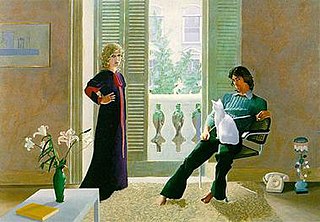
Mr and Mrs Clark and Percy is a 1971 painting by the British artist David Hockney. Painted between 1970 and 1971, it depicts the fashion designer Ossie Clark and the textile designer Celia Birtwell in their flat in Notting Hill Gate shortly after their wedding, with one of the couple's cats on Clark's knee. The white cat depicted in the painting was Blanche; Percy was another of their cats, but Hockney thought "Percy" made a better title.

Fertility in art refers to any artistic work representing or portraying fertility, which usually refers to successful breeding among humans, although it may also mean successful agriculture and animal husbandry. It includes engravings, drawings, paintings, sculptures, figurines, portraits and even literary works. In Paleolithic art, fertility is usually associated with figurines with exaggerated parts of human anatomy.

Dog types are broad categories of domestic dogs based on form, function, or style of work, lineage, or appearance. Some may be locally adapted dog types that may have the visual characteristics of a modern purebred dog. In contrast, modern dog breeds strictly adhere to long-established breed standards,[note 1] that began with documented foundation breeding stock sharing a common set of inheritable characteristics, developed by long-established, reputable kennel clubs that recognize the dog as a purebred.

Dogs have played a role in the religion, myths, tales, and legends of many cultures. They hold diverse and multifaceted roles in various religious traditions around the globe. These interpretations often revolve around the faithful and loyal nature of dogs, paralleling human devotion to higher powers.

The Pug is a breed of dog with the physically distinctive features of a wrinkly, short-muzzled face, and curled tail. An ancient breed, with roots dating back to 400 B.C., they have a fine, glossy coat that comes in a variety of colors, most often fawn or black, and a compact, square body with well developed and thick muscles all over the body.
Fidelity when personified in Western art stands for the secular aspect of Faith, or the trust that exists between a master and servant, or in family relationships. Fidelity is often represented as a woman, shown holding a golden seal and a key, but may also be represented by a dog. Fidelity may be shown alone, or may be accompanied by a dog, a symbol of not only faithfulness but also fidelity. In the Renaissance, Penelope or Griselda might also stand for fidelity. Fidelity is not in the usual lists of the seven virtues, though it may sometimes be included in such groupings. The plant myrtle (Myrtus) has been associated with fidelity, and hence used in weddings, from Roman times to the present, and wreathed crowns of myrtle may be found in art.

Rabbits and hares (Leporidae) are common motifs in the visual arts, with variable mythological and artistic meanings in different cultures. The rabbit as well as the hare have been associated with moon deities and may signify rebirth or resurrection. They may also be symbols of fertility or sensuality, and they appear in depictions of hunting and spring scenes in the Labours of the Months.
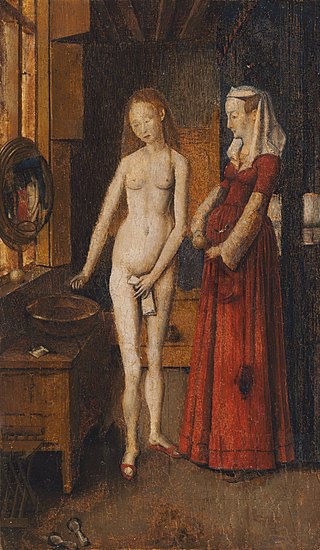
Woman Bathing is a lost panel painting by the Early Netherlandish artist Jan van Eyck. The work is today known through two copies which diverge in important aspects; one in Antwerp and a more successful but small c 1500 panel in Harvard University's Fogg Museum, which is in poor condition. It is unique in van Eyck's known oeuvre for portraying a nude in secular setting, although there is mention in two 17th-century literary sources of other now lost but equally erotic van Eyck panels.

The Alopekis is a small, ancient, primitive landrace of dog from Greece and adjacent regions of the Balkan peninsula. Alopekis have prick ears, a curved tail, and a double coat. Alopekis were bred as a multipurpose farm dog, functioning as a hunting dog, watchdog and shepherd. The dog is found throughout Greece but is most commonly seen in northern Greek regions with a lot of farmland and villages, such as Serres, Drama, Xanthi, etc. Critically endangered, the exact number of specimens that remain today is unknown.

Dog fashion is a popular style or practice, especially in canine clothing and accessories. Dog fashion is a distinctive trend of the style in which people dress their canine companions. This trend dates back to the Egyptian predynastic period and has since expanded due to increased consumer capitalism. Other animals such as cats may also wear fashion.



